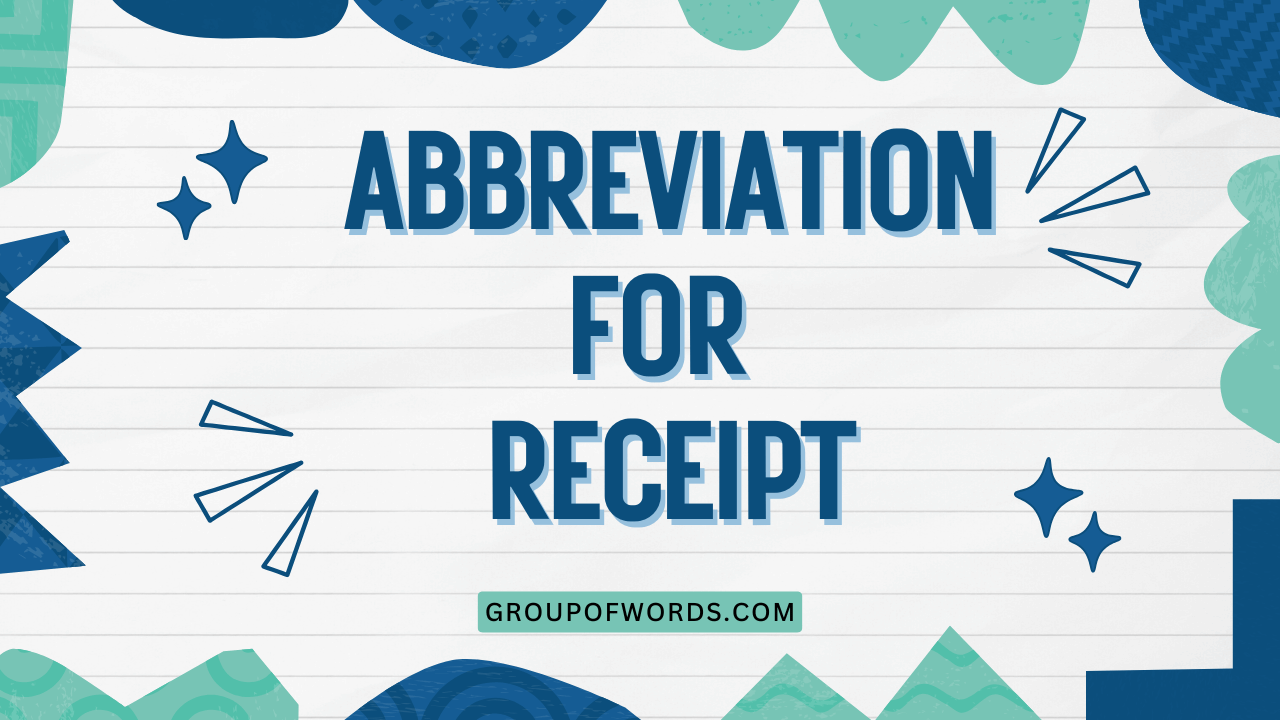“Receipt” Abbreviation: A Comprehensive Guide
Understanding abbreviations is crucial in everyday communication, especially in business and financial contexts. The abbreviation for “receipt” is frequently used in accounting, retail, and personal finance.
This article provides a thorough exploration of the abbreviation for ‘receipt,’ covering its definition, usage, common mistakes, and practical examples. Whether you are a student, a business professional, or someone managing personal finances, mastering this abbreviation will enhance your understanding and efficiency in dealing with financial documents.
This guide will walk you through the nuances of using ‘receipt’ abbreviations correctly, ensuring clarity and professionalism in your written communication. With detailed explanations, practical examples, and helpful exercises, you’ll gain the confidence to use this abbreviation effectively in various scenarios.
Table of Contents
- Introduction
- Definition of “Receipt” and Its Abbreviation
- Structural Breakdown of the Abbreviation
- Types of Receipts
- Examples of “Receipt” Abbreviation in Use
- Usage Rules for “Receipt” Abbreviation
- Common Mistakes When Using “Receipt” Abbreviation
- Practice Exercises
- Advanced Topics: Receipt Management and Digitalization
- Frequently Asked Questions (FAQ)
- Conclusion
Definition of “Receipt” and Its Abbreviation
A receipt is a written or electronic acknowledgment that something of value has been received, typically money, goods, or services. It serves as proof of a transaction. The most common abbreviation for “receipt” is “Rx” or “Rec.” While “Rec.” is more straightforward and widely understood, “Rx” has historical roots and is sometimes used in specific contexts, particularly in older documents or certain industries. Understanding both abbreviations and their appropriate contexts is essential for clear communication.
The term “receipt” is crucial in accounting, retail, and personal finance. It documents the specifics of a transaction, including the date, items purchased, amount paid, and the parties involved.
This documentation is essential for record-keeping, tax purposes, and resolving any disputes that may arise.
Structural Breakdown of the Abbreviation
The abbreviation “Rec.” is a shortened form of the word “receipt,” created by taking the first three letters followed by a period. The period indicates that it is an abbreviation.
This form is widely accepted and easily understood in most contexts. The abbreviation “Rx” is less intuitive.
It’s derived from the Latin word “recipe,” meaning “take.” Historically, pharmacists used “Rx” at the beginning of prescriptions, indicating what ingredients to take. Its association with receipts likely stems from this historical usage in financial and transactional contexts, where something is ‘taken’ or received in exchange for payment.
The use of a period after “Rec” is a standard convention for abbreviations in English. It signals that the word has been shortened.
However, in some informal contexts, the period might be omitted, though it’s generally recommended to include it for clarity and formality.
Types of Receipts
Receipts come in various forms, each serving a specific purpose. Understanding these types helps in recognizing and properly using the abbreviation in different contexts.
Sales Receipts
Sales receipts are the most common type, issued after a purchase of goods or services. They detail the items bought, the price, the date, and the seller’s information.
These are crucial for customers to return items, claim warranties, or track expenses.
Payment Receipts
Payment receipts confirm that a payment has been made, such as rent, utility bills, or invoices. These receipts are essential for both the payer and the payee to maintain accurate financial records.
Cash Receipts
Cash receipts specifically document cash transactions. They are important for businesses to reconcile their cash registers and track cash flow accurately.
Electronic Receipts (E-Receipts)
E-receipts are digital versions of receipts, often sent via email or stored in mobile apps. They are increasingly common due to their convenience and environmental benefits.
Donation Receipts
Donation receipts are issued by non-profit organizations to acknowledge charitable contributions. These receipts are important for donors to claim tax deductions.
Examples of “Receipt” Abbreviation in Use
Understanding how to use the abbreviation for “receipt” in various contexts is essential. The following tables provide examples of its usage in different scenarios.
Examples Using “Rec.”
The following table showcases the abbreviation “Rec.” in sentences, demonstrating its versatility and clarity.
| Sentence | Context |
|---|---|
| Please keep the Rec. for your records. | General |
| The accountant requested all Rec. from the past year. | Accounting |
| I need the Rec. to process your return. | Retail |
| Ensure you have a Rec. for every expense. | Finance |
| Can you provide the Rec. for this purchase? | General |
| The auditor reviewed all Rec. carefully. | Auditing |
| File the Rec. alphabetically by date. | Record-keeping |
| We need the Rec. to verify the transaction. | Banking |
| The Rec. confirms your payment. | Billing |
| Attach the Rec. to the expense report. | Business |
| I lost the Rec., can I get a duplicate? | Customer Service |
| The Rec. is required for warranty claims. | Warranty |
| Store the Rec. in a safe place. | Personal Finance |
| The Rec. shows the items purchased. | Retail |
| Verify the details on the Rec. | Accuracy Check |
| The Rec. serves as proof of purchase. | Legal |
| Hand over the Rec. to the cashier. | Point of Sale |
| The Rec. indicates the date of purchase. | Record Keeping |
| The Rec. is necessary for reimbursement. | Expense Claims |
| Without the Rec., we cannot process the refund. | Customer Service |
| The Rec. should be kept for tax purposes. | Taxation |
| The Rec. includes the store’s address and phone number. | Business Information |
| The Rec. details the method of payment. | Transaction Information |
| The Rec. is printed on thermal paper. | Receipt Type |
| The Rec. is scanned into our system. | Data Management |
| The Rec. confirms the final amount paid. | Payment Confirmation |
| The Rec. is stapled to the invoice. | Document Management |
| The Rec. is required for audit purposes. | Auditing |
| The Rec. must be presented at the time of return. | Return Policy |
Examples Using “Rx”
“Rx” is less common for general receipt usage but can appear in specific, especially older, contexts. The table below demonstrates its usage.
| Sentence | Context |
|---|---|
| Please present the Rx at the counter. | Older retail establishments |
| File the Rx with other financial documents. | Archival purposes |
| The Rx confirms the transaction’s authenticity. | Security and verification |
| The Rx should be kept for personal records. | Personal finance |
| The Rx serves as proof of payment. | Legal and financial contexts |
| The Rx is needed for insurance claims. | Insurance purposes |
| The Rx includes the company’s stamp. | Verification and authenticity |
| The Rx is stored digitally in our database. | Modern record-keeping |
| The Rx is a valuable document. | General importance |
| The Rx has a unique transaction ID. | Tracking and identification |
| The Rx is essential for warranty claims. | Consumer protection |
| The Rx confirms the date and time of purchase. | Record keeping |
| The Rx is issued immediately after the transaction. | Transaction process |
| The Rx must match the invoice details. | Verification and reconciliation |
| The Rx contains the customer’s signature. | Proof of agreement |
| The Rx is kept in a secure location. | Document security |
| The Rx is used to track sales performance. | Business analysis |
| The Rx includes a detailed breakdown of charges. | Transparency |
| The Rx is required for all returns and exchanges. | Return policy enforcement |
| The Rx is a legal document. | Legal compliance |
| The Rx is audited regularly for accuracy. | Financial audits |
| The Rx helps in managing expenses efficiently. | Financial management |
| The Rx is generated by the point-of-sale system. | Technology in retail |
| The Rx is sent to the customer via email. | Electronic communication |
| The Rx is used to resolve potential disputes. | Conflict resolution |
Examples in Different Contexts
This table illustrates how the “Rec.” abbreviation can be used in various professional settings.
| Context | Example Sentence |
|---|---|
| Accounting | Our accounting department requires all employees to submit their Rec. for expense reimbursement. |
| Retail | Please provide the Rec. for any returns or exchanges. |
| Finance | Keep all your Rec. organized for tax season. |
| Business | The manager needs to review all Rec. for the month. |
| Customer Service | If you have any issues, please refer to your Rec. number. |
| Auditing | The auditors will examine all financial Rec. for accuracy. |
| Record-keeping | Maintain a file of all important Rec. for future reference. |
| Banking | The bank teller asked for the deposit Rec. as proof of transaction. |
| Billing | The billing statement will include a reference to the original Rec. date. |
| Warranty | The product warranty is valid only with the original Rec. |
| Personal Finance | Always save your Rec. to track your spending and budget effectively. |
| Legal | The Rec. can serve as legal proof of purchase in case of disputes. |
| Point of Sale | The cashier handed me the Rec. after the transaction was completed. |
| Insurance | Submit the Rec. with your claim form to verify the expense. |
| Travel | Keep your travel Rec. for expense reports and reimbursement. |
| Education | Students should keep their tuition Rec. for tax credit purposes. |
| Healthcare | The medical Rec. is required for insurance claims. |
| Real Estate | The property tax Rec. is needed for annual tax filings. |
| Investments | Keep your investment Rec. for capital gains tax calculations. |
| Government | Government agencies require detailed Rec. for all expenditures. |
| Non-Profits | Non-profit organizations issue donation Rec. for tax-deductible contributions. |
| E-commerce | Online stores provide e-Rec. for all purchases made on their platform. |
| Restaurant | Restaurants provide Rec. after a meal, detailing the items ordered and the total cost. |
| Entertainment | The ticket Rec. is required for entry to concerts and events. |
| Automotive | Car repair shops provide Rec. for all services performed on vehicles. |
| Rental Services | Rental companies provide Rec. for equipment or vehicle rentals. |
| Subscription Services | Subscription services send Rec. for recurring payments. |
| Online Advertising | Advertising platforms provide Rec. for advertising expenses. |
Usage Rules for “Receipt” Abbreviation
To use the abbreviation for “receipt” correctly, follow these guidelines:
- Use “Rec.” in general business and financial contexts. This abbreviation is widely recognized and easily understood.
- Consider “Rx” for historical contexts or when referring to older documents. Be mindful that this abbreviation is less common in modern usage.
- Always include a period after the abbreviation. The period indicates that the word has been shortened.
- Ensure context clarity. Make sure the abbreviation is clear within the context of the sentence or document.
- Be consistent. Choose one abbreviation (either “Rec.” or “Rx”) and use it consistently throughout your document.
- Avoid using the abbreviation in formal writing. In formal reports or legal documents, spell out the word “receipt” in full for clarity.
Common Mistakes When Using “Receipt” Abbreviation
Avoid these common mistakes when using the abbreviation for “receipt”:
| Incorrect | Correct | Explanation |
|---|---|---|
| Please keep the rec for your records. | Please keep the Rec. for your records. | Missing period after the abbreviation. |
| The accountant requested all recs from the past year. | The accountant requested all Rec. from the past year. | Incorrect pluralization of the abbreviation. The abbreviation itself doesn’t need to be pluralized. |
| I need the Rx to process your return (in a modern retail store). | I need the Rec. to process your return. | Using “Rx” in an inappropriate context. |
| Ensure you have a receipt for every expense. (in an informal note) | Ensure you have a Rec. for every expense. | While not strictly incorrect, using the full word in an informal context when an abbreviation is appropriate can be less efficient. |
| Can you provide the RX for this purchase? | Can you provide the Rec. for this purchase? | “RX” is the wrong casing. |
Practice Exercises
Test your understanding with these practice exercises. Fill in the blanks with the correct abbreviation for “receipt” (“Rec.” or “Rx”) based on the context.
Exercise 1
Choose the correct abbreviation (“Rec.” or “Rx”) for each sentence.
| Question | Answer |
|---|---|
| 1. Please provide the ____ for your purchase to receive a refund. | Rec. |
| 2. The accountant needs all ____ from last month to balance the books. | Rec. |
| 3. Keep your ____ organized in a folder for tax purposes. | Rec. |
| 4. The store requires a ____ for all returns. | Rec. |
| 5. I can’t find my ____; can I get a duplicate? | Rec. |
| 6. The ____ confirms your payment was successfully processed. | Rec. |
| 7. Attach the ____ to your expense report for reimbursement. | Rec. |
| 8. The ____ is needed to verify the transaction. | Rec. |
| 9. You must present the ____ to claim the warranty. | Rec. |
| 10. Please file the ____ alphabetically by date. | Rec. |
Exercise 2
Rewrite the following sentences using the abbreviation “Rec.” or “Rx” where appropriate.
| Question | Answer |
|---|---|
| 1. Please keep the receipt for your records. | Please keep the Rec. for your records. |
| 2. The accountant requested all receipts from the past year. | The accountant requested all Rec. from the past year. |
| 3. I need the receipt to process your return. | I need the Rec. to process your return. |
| 4. Ensure you have a receipt for every expense. | Ensure you have a Rec. for every expense. |
| 5. Can you provide the receipt for this purchase? | Can you provide the Rec. for this purchase? |
| 6. The auditor reviewed all financial receipts carefully. | The auditor reviewed all financial Rec. carefully. |
| 7. File the receipts alphabetically by date. | File the Rec. alphabetically by date. |
| 8. We need the receipt to verify the transaction. | We need the Rec. to verify the transaction. |
| 9. The receipt confirms your payment. | The Rec. confirms your payment. |
| 10. Attach the receipt to the expense report. | Attach the Rec. to the expense report. |
Advanced Topics: Receipt Management and Digitalization
Beyond understanding the abbreviation, advanced learners should explore receipt management and digitalization.
Receipt Management Systems
Modern businesses use sophisticated systems to manage receipts, including scanning, categorizing, and storing them digitally. These systems streamline expense tracking and financial reporting.
Digitalization of Receipts
The shift towards e-receipts has transformed how receipts are stored and accessed. Digital receipts offer benefits like easy storage, searchability, and environmental sustainability.
Understanding how to manage and organize e-receipts is crucial for modern financial management.
Mobile Apps for Receipt Tracking
Numerous mobile apps are available to help individuals and businesses track and manage receipts. These apps often include features like automatic scanning, expense categorization, and report generation.
Frequently Asked Questions (FAQ)
Here are some frequently asked questions about the abbreviation for “receipt”:
- Is it always necessary to include a period after “Rec.”?
Yes, including a period after “Rec.” is a standard convention in English to indicate that it is an abbreviation. While it might be omitted in very informal contexts, it is generally recommended for clarity and formality.
- When should I use “Rx” instead of “Rec.”?
“Rx” is less common for general receipt usage and is more likely to be found in historical contexts or specific industries. In most modern business and financial settings, “Rec.” is the preferred abbreviation. Use “Rx” if you are dealing with older documents or if it is the established convention in a particular field.
- Can I use “rcpt” as an abbreviation for “receipt”?
While “rcpt” is sometimes used informally, it is not a standard or widely recognized abbreviation. It is best to stick with “Rec.” for clarity and professionalism.
- Is it acceptable to pluralize the abbreviation (e.g., “Recs.”)?
No, it is not correct to pluralize the abbreviation itself. When referring to multiple receipts, use “Rec.” followed by the plural noun it modifies (e.g., “the Rec. for these items”).
- How do I cite a receipt in a research paper or academic context?
In academic writing, it is generally best to spell out the word “receipt” in full to maintain formality and clarity. If you must abbreviate, ensure it is consistent with the style guide you are following (e.g., APA, MLA, Chicago).
- What is the difference between a receipt and an invoice?
A receipt is issued after a payment has been made, serving as proof of purchase. An invoice, on the other hand, is a request for payment, detailing the goods or services provided and the amount due.
- Can an electronic receipt be used as proof of purchase?
Yes, electronic receipts are widely accepted as valid proof of purchase. They have the same legal standing as paper receipts, provided they contain the necessary information, such as the date, items purchased, amount paid, and the seller’s information.
- What should I do if I lose a receipt?
If you lose a receipt, contact the seller to request a duplicate. Many businesses keep records of transactions and can provide a copy. If it was an electronic transaction, check your email or online account for a digital copy.
Conclusion
Mastering the abbreviation for “receipt” is essential for clear and effective communication in various contexts. While “Rec.” is the most common and widely accepted abbreviation, understanding the historical usage of “Rx” can also be beneficial.
By following the usage rules and avoiding common mistakes, you can confidently use these abbreviations in your written communication.
Remember to always prioritize clarity and context when using abbreviations. In formal writing, it is often best to spell out the word “receipt” in full.
By practicing and applying these guidelines, you will enhance your understanding and proficiency in using the abbreviation for “receipt” effectively.






